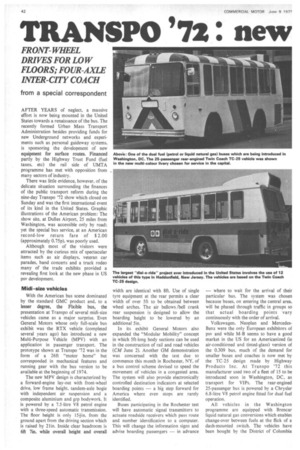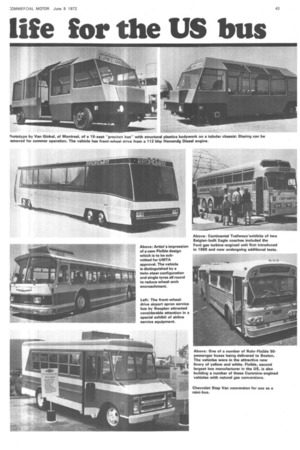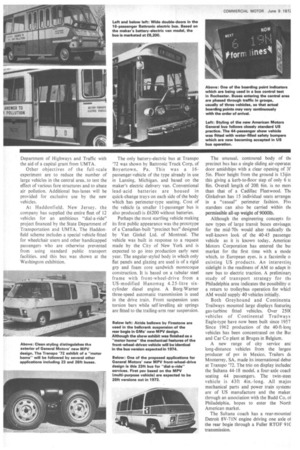TRANSPO '72 : new life for the US bus
Page 44

Page 45

Page 46

If you've noticed an error in this article please click here to report it so we can fix it.
from a special correspondent
AFTER YEARS of neglect, a massive effort is now being mounted in the United States towards a renaissance of the bus. The recently formed Urban Mass Transport Administration besides providing funds for new Underground networks and experiments such as personal guideway systems, is sponsoring the development of new equipment for surface routes. Financed partly by the Highway Trust Fund (fuel taxes, etc) the rail side of UMTA programme has met with opposition from many sectors of industry.
There was little evidence, however, of the delicate situation surrounding the finances of the public transport reform during the nine-day Transpo '72 show which closed on Sunday and was the first international event of its kind in the United States. Graphic illustrations of the American problem: The show site, at Dulles Airport, 25 miles from Washington, was accessible only by road; yet the special bus service, at an American record-low return fare of $ 2.00 (approximately 0.75p), was poorly used.
Although most of the visitors were attracted by the curious mix of spectacular items such as air displays, veteran car parades, band concerts and a truck rodeo many of the trade exhibits provided a revealing first look at the new phase in US psv development.
Midi–size vehicles With the American bus scene dominated by the standard GMC product and, to a lesser degree, the Flxible bus, the presentation at Transpo of several midi-size vehicles came as a major surprise. Even General Motors whose only full-scale bus exhibit was the RTX vehicle (completed several years ago) has introduced a new Multi-Purpose Vehicle (MPV) with an application in passenger transport. The prototype shown at Transpo '72 was in the form of a 26ft "motor home" but corresponded in mechanical features and running gear with the bus version to be available at the beginning of 1974.
The new MPV design is characterized by a forward-engine lay-out with front-wheel drive, low frame height, tandem-axle bogie with independent air suspension and a composite aluminium and grp bodywork. It is powered by a 7.5-litre V8 petrol engine with a three-speed automatic transmission. The floor height is only 15-41-in. from the ground apart from the driving section which is raised by 21in. Inside clear headroom is 6ft 7in. while overall height and overall
width are identical with 8ft. Use of single tyre equipment at the rear permits a clear width of over 5ft to be obtained between wheel arches. The air bellows /bell crank rear suspension is designed to allow the boarding height to be lowered by an additional 5in.
In its. exhibit General Motors also expanded the "Modular Mobility" concept in which 5ftlong body sections can be used in the construction of rail and road vehicles (CM June 2). Another GM demonstration was concerned with the test due to commence this month in Rochester, NY, of a bus control scheme devised to speed the movement of vehicles in a congested area. The system will also provide electronically controlled destination indicators at selected boarding points — a big step forward for America where even stops are rarely identified.
Buses participating in the Rochester test will have automatic signal transmitters to actuate roadside receivers which pass route and number identification to a computer. This will change the information signs and advise boarding passengers — in advance — where to wait for the arrival of their particular bus. The system was chosen because buses, on entering the central area, will be phased through traffic in groups so that actual boarding points vary continuously with the order of arrival.
Volkswagen, Neoplan and MercedesBenz were the only European exhibitors of psv and while M-B seems to have a good market in the US for an Americanized (ie air-conditioned and tinted-glass) version of the• 0.309 bus, much of the demand for smaller buses and coaches is now met by the TC-25 design made by Highway Products Inc. At Transpo '72 this manufacturer used two of a fleet of 15 to be introduced soon in Washington, DC, as transport for VIPs. The rear-engined 25-passenger bus is powered by a Chrysler 6.8-litre V8 petrol engine fitted for dual fuel operation.
All vehicles in the Washington programme are equipped with Brencar liquid natural gas conversions which enables change-over between fuels at the flick of a dash-mounted switch. The vehicles have been bought by the District of Columbia Department of Highways and Traffic with the aid of a capital grant from UMTA.
Other objectives of the full-scale experiment are to reduce the number of large vehicles in the central area, to test the effect of various fare structures and to abate air pollution. Additional bus-lanes will be provided for exclusive use by the new vehicles.
At I4addonfield, New Jersey. the company has supplied the entire fleet of 12 vehicles for an ambitious "dial-a-ride" project financed by the State Department of Transportation and UMTA. The Haddonfield scheme includes a special vehicle fitted for wheelchair users and other handicapped passengers who are otherwise prevented from using standard public transport facilities, and this bus. was shown at the Washington exhibition.
The only battery-electric bus at Transpo '72 was shown by Battronic Truck Corp, of Boyertown, Pa. This was a 16passenger-vehicle of the type already in use in Lansing. Michigan, and based on the maker's electric delivery van. Conventional lead-acid batteries are housed in quick-change trays on each side of the body which has perimeter-type seating. Cost of the vehicle (a smaller 11-passenger bus is also produced) is £6200 without batteries. .
Perhaps the most startling vehicle making its first public appearance was the prototype of a Canadian-built "precinct bus" designed by Van Ginkel Ltd, of Montreal. The vehicle was built in response to a request made by the City of New York and is expected to go into production early next year. The angular-styled body in which only flat panels and glazing are used is of a rigid grp and foam core sandwich monocoque construction. It is based on a tubular steel frame with front-wheel-drive from a US-modified Hanornag 4.25-litre sixcylinder diesel engine. A Borg-Warner three-speed automatic transmission is used in the drive train. Front suspension uses torsion bars while self-levelling air springs are fitted to the trailing-arm rear suspension.
The unusual, contoured body of thi precinct bus has a single sliding air-operate< door amidships with a clear opening of 3f 5in. Floor height from the ground is 13i-in this giving a kerb-to-floor step of only 6 t( 8in. Overall length of 20ft 6in. is no moo than that of a Cadillac Fleetwood. Ttu Ginkelvan has 15 individual seats arrange( in a "casual" perimeter fashion. Fiv( standees can also be carried within tho permissible all-up weight of 90001b.
Although the engineering concepts foi new types of large transit buses envisage( for the mid-70s would alter radically fru well-known look of the 40-45 passengei vehicle as it is known today, Americat Motors Corporation has entered the bu; market for the first time with a mode which, to European eyes. is a facsimile o existing US products. An interestint sidelight is the readiness of AM to adapt it new bus to electric traction. A preliminan study of transport strategy for thi Philadelphia area indicates the possibility o a return to trolleybus operation for whicl AM would supply 40 vehicles initially.
Both Greyhound and Continenta Trailways mounted large displays featurirq gas-turbine fitted vehicles. Over 250( vehicles of Continental Trailways Eagle-type have now been built since 1957 Since 1962 production of the 40-ft-lorq vehicles has been concentrated on the Bu and Car Co plant at Bruges in Belgium.
A new range of city service anc long-distance vehicles from the largesi producer of psv in Mexico, Trailers di Monterrey. SA, made its international debui at Transpo '72. The trio on display includec the Sultana 44-18 model, a four-axle coact seating 44 passengers. The twin-steer vehicle is 43ft 4in.-long. All majoi mechanical parts and power train system! are of US manufacture and the maker through an association with the Budd Co, ol Philadelphia, hopes to enter the North American market.
The Sultana coach has a rear-mounted Detroit 8V-71N engine driving one axle ol the rear bogie through a Fuller RTOF 91C transmission.




































































































